WHAT IS ADDITIVE MASTOPLASTIC?
The breast augmentation is surgery to increase breast size and is one of the most requested interventions in cosmetic surgery. With the intervention of breast augmentation, whose history began in 1895, it is possible to change the shape and size of a breast that is too small or to correct a breast asymmetry by improving the harmony of the body and one’s sense of self-esteem.
WHO IS THIS TYPE OF INTERVENTION FOR?
L ‘ breast augmentation surgery is indicated for women who wish to:
- make your breasts more proportionate and voluminous than your body;
- restore shape and volume to a breast that has wasted with pregnancy and breastfeeding;
- correct a breast asymmetry, i.e. improve a difference in volume between the two breasts.
BREAST PROSTHESIS
The choice of prostheses is a very delicate and important phase which strongly affects the final result of the intervention. It is the plastic surgeon’s task to choose a type of prosthesis that is suitable for the patient’s physical conformation and the characteristics of her tissues, in order to obtain the most natural breast possible.
Currently there are different types of prostheses on the market that differ in shape, surface and content .
The prostheses can have a round shape or with an anatomical profile (drop shape) or be ergonomic (at the same time have an anatomical shape and a round shape). The former are more suitable for patients whose breasts have a harmonious shape and want a moderate increase in volume or for those women who, following one or more pregnancies, have “emptied” and / or sagging breasts, while prostheses with anatomical profile they are indicated for women with very little breasts or who wish to obtain a very natural effect. Ergonomic prostheses they are the novelty of recent times and allow to have at the same time the advantage of being anatomical and round, but they can only be positioned in patients who are not very thin and have not too thin tissues in the breast region. Furthermore, some prostheses offer different degrees of projection (low, medium and high) depending on the degree of projection that the patient intends to obtain. Externally, breast implants can have a smooth or rough surface (smooth or textured implants). The Smooth-surfaced implants have a shell slightly softer and is hardly perceptible to the touch even when they are positioned under the mammary gland. The prosthesis textured on the other hand, they are a little more rigid to the touch, but are preferred by many surgeons as they experience less “rejection” (capsular contracture).
The prostheses used in breast augmentation surgery consist of an external silicone casing and an internal content that is always made of silicone gel. Silicone gel is a highly cohesive and uniform material which, despite having the softness and consistency of the breast tissue, acts as a solid substance allowing to avoid, in the event of accidental breakage of the implant, the migration and dispersion of its contents. within the mammary region.
The implants with silicone gels are available in three different degrees of cohesiveness (soft, slightly thick and very dense) in order to ensure the highest level of resistance, safety and comfort. Prostheses with saline solution are no longer used nowadays.
The best breast implants are produced by the Mentor , Motiva and Polytec companies . The American company Mentor has always been a guarantee of solidity and reliability, while a recent innovation is the Motiva ergonomic prostheses for technological innovation and the polyurethane prostheses of the German company Polytech .
All the latest generation prostheses guarantee the maximum degree of safety, resistance and comfort. The most important manufacturers like Mentor and Motiva guarantee prostheses no longer for ten years as it was until a few years ago, but for a lifetime. Over time, the prostheses can be replaced by personal choice (if the patient wishes to change the type or size of the implant) or due to the onset of complications (e.g. capsular contracture) or breakages.
THERE ARE AGE LIMITS FOR SUBJECTING ADDITIVE MASTOPLASTY
It is not possible by law to undergo breast augmentation under the age of 18, unless there is a pathology in the young minor patient. Breast augmentation can also be done in women over 70.
WHAT OTHER INTERVENTIONS CAN BE CARRIED OUT TOGETHER WITH ADDITIVE MASTOPLASTICS?
Breast augmentation can be performed alone or in combination with other surgical techniques such as mastopexy, tummy tuck, liposuction or other cosmetic surgery.
WHAT ARE THE RISKS AND COMPLICATIONS OF THIS TYPE OF INTERVENTION?
Breast augmentation surgery is a fairly simple surgical procedure that generally gives excellent results, of great satisfaction both for the patient and for the surgeon who performs it. Many thousands of breast augmentation plasters are successfully performed worldwide every year.
However, it is necessary not to underestimate the nature and risks of a surgical intervention and not to give in to the temptation to contact non-specialist doctors who offer services at relatively modest prices in unauthorized structures (beauty centers, clinics, etc.), because it is still a serious surgery, where complications are rare but can happen and be easily overcome only if the intervention is performed by a specialist in plastic surgery within duly authorized facilities.
A possible complication of breast augmentation is the so – called capsular contracture(or “rejection of the prosthesis”) which derives from the reaction of the organism to the introduction of a foreign body. Capsular contracture consists in the formation of a scar (or “capsule”) all around the prosthesis which can, over time, cause pain and compromise the aesthetic result of the intervention. Infection, hypersensitivity or hyposensitivity of the areola or nipple, dislocation of the prosthesis or formation of skin folds around the implant can rarely occur. To reduce the risk of complications, however, it is essential to follow exactly the advice and instructions that the surgeon will give you before and after the operation. smokers should decrease the use of cigarettes because smoking can increase the risk of complications and healing delays.
HOW IS THE PRE-OPERATIVE VISIT DONE?
Breast augmentation is a very personalized intervention which, as such, requires an accurate specialist visit. During the first visit, the surgeon will have to evaluate the shape and size of the breast, areola and nipple and illustrate the possible changes in shape and volume that the most modern surgical technique makes available for your case. The surgeon will also have to evaluate your state of health to rule out the presence of changes (such as high blood pressure, clotting or scarring problems) that could affect the final result of the surgery. Before the operation you will receive precise instructions on pre and post-operative nutrition, on the intake of drugs, alcohol and cigarettes. At the end of the visit, the surgeon, in agreement with you, will choose the type of prosthesis to be used for breast surgery, the most suitable access route (periareolar, from the submammary sulcus or from the axillary route) and the correct positioning of the implant (sub-glandular, dual plane or submuscular). The prostheses used in breast augmentation surgery are made up of an external silicone casing and an internal content which can be no longer a saline silicone gel. Other substances used in the past, such as soybean oil or other, have been gradually abandoned. Depending on the shape of the breast that the plastic surgeon wants to obtain, you can choose one from the submammary sulcus or from the axillary way) and the correct positioning of the implant (sub-glandular, dual plane or submuscular). The prostheses used in breast augmentation surgery are made up of an external silicone casing and an internal content which can be no longer a saline silicone gel. Other substances used in the past, such as soybean oil or other, have been gradually abandoned. Depending on the shape of the breast that the plastic surgeon wants to obtain, you can choose one from the submammary sulcus or from the axillary way) and the correct positioning of the implant (sub-glandular, dual plane or submuscular). The prostheses used in breast augmentation surgery are made up of an external silicone casing and an internal content which can be no longer a saline silicone gel. Other substances used in the past, such as soybean oil or other, have been gradually abandoned. Depending on the shape of the breast that the plastic surgeon wants to obtain, you can choose one Other substances used in the past, such as soybean oil or other, have been gradually abandoned. Depending on the shape of the breast that the plastic surgeon wants to obtain, you can choose one Other substances used in the past, such as soybean oil or other, have been gradually abandoned. Depending on the shape of the breast that the plastic surgeon wants to obtain, you can choose one round prosthesis or a prosthesis with anatomical or drop profile . Externally, breast implants can be smooth or rough (textured). Smooth surface implants have a slightly softer coating and are less likely to be perceived by touch, even if placed under the mammary gland. Textured prostheses, on the other hand, are a little more rigid but today more used than smooth ones because they give less “rejection” (so-called capsular contracture) once inserted into the breast region.
Most manufacturers guarantee breast implants for life, even if they recommend replacing them to avoid any deformation or deflation of the prosthesis due to prolonged use of the same. The replacement of the prosthesis can be a matter of personal choice (in case you want to change the type or size of the prosthesis) or a necessity due to the onset of complications (e.g. capsular contracture) and can take place after a few years or after 10-20 years after surgery.
WHERE ARE THE ENGRAVINGS MADE?
The access routes most used in breast augmentation surgery are from the areola, the submammary sulcus or the axillary region. The incisions are not very visible as they remain hidden, respectively, along the contour of the areola or in the skin folds of the armpit or breast. The breast implants can be positioned below the pectoralis major muscle or below the mammary gland or with dual plane technique
SURGICAL TECHNIQUES
The intervention of breast augmentation occurs through the insertion of breast implants below the mammary gland or the pectoralis major muscle or with the dual plane technique . The positioning of the prosthesis under the mammary gland makes the surgeon’s work easier, but has the disadvantage of making the prosthesis more palpable and visible and the mammography examination more difficult. The positioning below the pectoralis major muscleon the other hand, it allows to reduce the visibility of the prosthesis and the risk of a capsular contracture and to facilitate the mammographic examination, but it entails a longer duration of the intervention and of the post-operative period and the risk of moving the prosthesis upwards. To overcome these drawbacks, a new technique called Dual Plane has been developed which consists in placing the upper part of the prosthesis under the pectoralis major muscle (where the skin is thinner and the risk of palpability of the prosthesis is higher) and the lower part under the gland (to reduce the risk of moving upwards and get a more natural looking breast). The positioning of the prosthesis below the pectoralis major muscle generally allows to obtain a better, more natural and longer lasting aesthetic result, also reducing the risk of capsular contracture that could occur as a consequence of the implantation of a breast prosthesis.
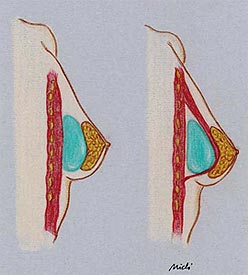
and submuscular prostheses .
WHAT TYPE OF ANESTHESIA IS PRACTICED?
Breast augmentation is generally performed under day-hospital conditions and under general anesthesia with or without intubation (i.e. only with the aid of the laryngeal mask). Sometimes it can also be performed under local anesthesia with sedation (which allows the patient to remain awake, but relaxed and insensitive to pain). In rare cases, hospitalization for one or two nights may be required. Before the operation, the anesthesiologist will perform an accurate pre-operative visit and prescribe a list of routine tests such as: EKG, CBC, PT, PTT, fibrinogen, Electrolytes, Glycemia, azotemia, creatinemia, Serology (hepatitis B, C virus and HIV), breast examination with breast ultrasound and / or mammography.
HOW LONG DOES THE INTERVENTION LAST?
The breast augmentation surgery lasts about 1 hour and ends with a dressing consisting of a bra that will be replaced after a few days.
WHAT IS THE POST-OPERATIVE COURSE OF MASTOPLASTICS?
In the 48 hours following the breast augmentation surgery you will have to rest. Starting from the third day, you can resume a normal life while avoiding strenuous activities, saunas, Turkish baths and sun exposure. Swelling, bruising and soreness in the breast region may occur in the first two days. After 4-5 days you can resume your work if not too tiring. Three weeks after the surgery, you will gradually resume all normal activities including sports.
WHAT TYPE OF RESULT CAN BE OBTAINED?
Breast augmentation generally gives very good results and great satisfaction for the patient and for the surgeon who performs it. The result achieved is long-lasting but cannot be said to be completely permanent because it is subject to the normal aging processes of the body and to the effects of gravity.
ADDITIVE MASTOPLASTY: COSTS
Case 1
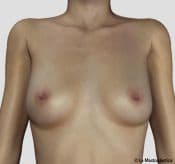
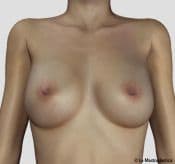
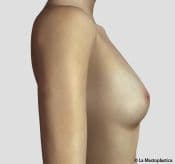
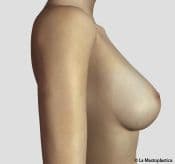
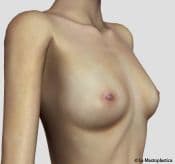
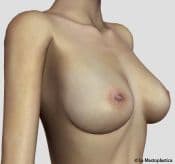
Case 2
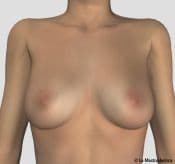
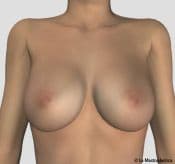
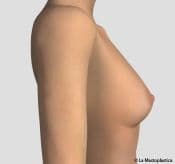
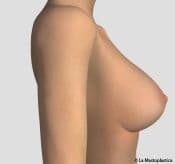
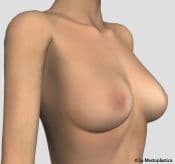
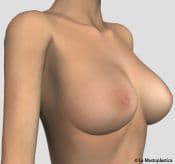
Case 3
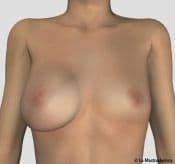
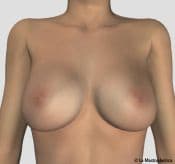
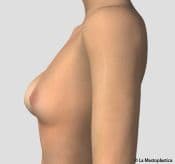
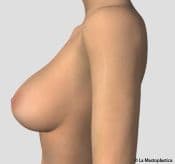
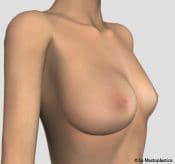
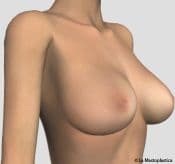
RISKS AND POSSIBLE COMPLICATIONS OF ADDITIVE MASTOPLASTY
Breast augmentation is a fairly simple surgery that generally gives very good results and great satisfaction for the patient. Millions of breast augmentation plasters are successfully performed worldwide every year. However, it is necessary not to underestimate the nature and risks of this surgery and to absolutely avoid contacting non-specialist doctors who offer low-cost services in unauthorized structures (beauty centers, clinics, etc.), because every surgical procedure presents risks and can go encountering complications that can be easily overcome only if the intervention is performed by a specialist in plastic surgery within duly authorized structures.
The complications of breast augmentation include:
THE CAPSULAR CONTRACT:
The breast implants are made of silicone gel or physiological solution wrapped in a solid silicone casing, the “bio-compatible” material par excellence, which in any case determines a foreign body reaction consisting of the formation of a fibrous film, along the walls of the housing pocket, which wraps around the shell of the implant. In practice, a sort of internal healing takes place through the production of a membrane surrounding the prostheses, more adherent in the case of textured or polyurethane-coated implants compared to smooth prostheses. This “natural” casing generally performs a positive function because it isolates the prostheses from the rest of the organism and stabilizes them in the correct position, limiting the tendency of the implant to migrate downwards.
Sometimes, however, the reaction of the organism is not so mild and functional, and it can happen that thick and rigid periprosthetic capsules are formed, which tighten the prostheses until they become hard and deformed. This phenomenon is called “periprosthetic capsule contracture”.
To define the hardness of the breast and the intensity of the contracture , the Baker scale is used, which operates a classification on the basis of four different grades :
- in the first degree the consistency of the breast is perfectly equal to the natural one and therefore the prosthesis is not palpable or visible;
- in II degree the implant is palpable but not visible. The breast with the prosthesis is less soft than a “normal” breast and it is perceived that a foreign body is housed inside it, although it is not easy to distinguish it clearly. Many women with insertable breasts in this group do not complain about the problem at all and often interpret it as a greater tonicity;
- in the third degree the prosthesis is palpable and visible with a tendency to attach itself to the neighboring tissues in an unnatural way;
- the fourth degree includes the most severe contractures due to which the breasts appear hard (sometimes like real stones), cold and deformed, with embarrassing dislocations. Grade IV contractures often also cause a certain soreness, sometimes intermittent, more rarely continuous and nagging.
The contracture of the periprosthetic capsuleit is the most frequent complication since the dawn of breast augmentation. In the 1980s, around 30% of implanted prostheses underwent this complication within a few years, often even within a few months. Currently the percentage is very low and has averaged around 1-2% for prostheses positioned below the pectoral muscle or Dual Plane. The role of drug therapy in contracture prevention is rather debated, especially regarding the use and efficacy of corticosteroids. Instead, the effectiveness of Zafirlukast (Accoleit 20 mg) in concretely reducing contractures and in treating already manifest ones has been demonstrated. Zafirlukast is a drug used in the treatment of asthma, the anti-inflammatory effect of which is due to the inhibition of leukotrienes, chemical compounds produced by leukocytes that contribute to inflammatory reactions. The dosage to be administered is 20 mg twice a day for a few months. In addition, some surgeons use external ultrasound to treat and prevent hardening of the prosthesis. In fact, ultrasound has a proven anti-inflammatory effect; moreover, thanks to the micromassage they produce, they improve lymphatic drainage helping to resolve local edema; they increase tissue oxygenation and cellular metabolism, stimulating the healing and high frequency vibration that they determine contributes to crushing the capsule by means of a fibrolytic effect. The dosage to be administered is 20 mg twice a day for a few months. In addition, some surgeons use external ultrasound to treat and prevent hardening of the prosthesis. In fact, ultrasound has a proven anti-inflammatory effect; moreover, thanks to the micromassage they produce, they improve lymphatic drainage helping to resolve local edema; they increase tissue oxygenation and cellular metabolism, stimulating the healing and high frequency vibration that they determine contributes to crushing the capsule by means of a fibrolytic effect. The dosage to be administered is 20 mg twice a day for a few months. In addition, some surgeons use external ultrasound to treat and prevent hardening of the prosthesis. In fact, ultrasound has a proven anti-inflammatory effect; moreover, thanks to the micromassage they produce, they improve lymphatic drainage helping to resolve local edema; they increase tissue oxygenation and cellular metabolism, stimulating the healing and high frequency vibration that they determine contributes to crushing the capsule by means of a fibrolytic effect. thanks to the micromassage they produce, they improve lymphatic drainage helping to resolve local edema; they increase tissue oxygenation and cellular metabolism, stimulating the healing and high frequency vibration that they determine contributes to crushing the capsule by means of a fibrolytic effect. thanks to the micromassage they produce, they improve lymphatic drainage helping to resolve local edema; they increase tissue oxygenation and cellular metabolism, stimulating the healing and high frequency vibration that they determine contributes to crushing the capsule by means of a fibrolytic effect.
BREAKING THE PROSTHESIS:
Breast implants, like any other prosthesis, undergo progressive wear and sometimes breakage. The duration of the prosthesis is highly variableand it depends on various factors including the quality of the prosthesis used, the different surgical techniques, the type of incision, the seat and the depth of housing and the instruments used. An important role also plays the tissue characteristics of the patients (very different from one subject to another), the lifestyle and the subjective potential to suffer trauma, the different intensity and duration of exposure to the sun, the willingness to follow the prescriptions medical, etc. It is therefore not possible to establish a priori and in a generalized way whether the average life of a prosthesis can be 10, 15, 20 or more years. It is recommended, at the slightest doubt of possible breakage, to carry out specific tests. Breast ultrasound is able to offer useful diagnostic clues, sufficient in most cases to ascertain cases of actual breakage of the prosthesis. In doubtful cases it is better to resort to nuclear magnetic resonance imaging, although it is a more demanding and expensive examination. In any case, no type of instrumental examination allows a 100% certain diagnosis of prosthetic breakage.
OTHER COMPLICATIONS:
Blood and serous collections, infection, hypersensitivity or hyposensitivity of the areola or nipple, dislocation of the prosthesis, slight breast asymmetry, formation of skin folds around the implant can rarely occur. Scientific studies, including those carried out by the IOM and the IRG, have excluded the possibility of the passage of harmful substances from the prosthesis to breast milk. When the prosthesis is positioned by means of a periareolar surgical incision, the possibility of breastfeeding may be reduced. To reduce the risk of complications, however, it is essential to carefully follow the advice and instructions given by the surgeon before and after surgery.
Smokers should decrease the use of cigarettes because smoking can increase the risk of complications and cause healing delays. During the visit and before the surgery, the surgeon will give you all the necessary information, including that relating to the risks and complications associated with this type of surgery. The patient is required to issue her consent to the surgery by signing the consent form drawn up by the Italian Society of Plastic Reconstructive and Aesthetic Surgery (SICPRE)
FAQ ADDITIVE MASTOPLASTIC
Q. What is breast augmentation?
A. Breast augmentation is the cosmetic surgery that serves to increase or enlarge the volume of a small, emptied or falling breast through the insertion of silicone implants that are positioned above or below the breast muscle.
Q. In which cases is breast augmentation indicated?
A. This type of intervention is indicated in cases of too small breasts, of breasts falling after pregnancy and breastfeeding, of breasts whose volume has decreased following a strong weight loss or when there is asymmetry of the breasts in the sense that a breast is larger than the other.
Q. At what age can breast augmentation be done?
A. The surgery can be performed at any age as long as the breasts are fully developed.
Q. Is breast augmentation surgery painful?
A. No. After surgery, a slight soreness may occur in the breast region which can be effectively controlled with analgesics.
Q. Will the remade breast look natural?
A. A breast operated with breast augmentation is similar to a natural breast provided that the prostheses used are of a shape and size suitable for the patient’s body, are positioned under the pectoral muscle and no complications arise such as capsular contracture.
Q. Can the breast operated by prosthesis be recognized by touch?
A. If the prostheses are well positioned and there are no reactions from the body (such as capsular contracture), the operated breast is very natural and soft to the touch.
Q. How long does the operation last and how long will it take me to recover?
A. The surgery normally lasts from one to two hours and is performed under general anesthesia or under local anesthesia with sedation. The next day you can go home and the feeling of soreness will disappear within a week. Superficial sutures are removed after two weeks. You can feel tired and sore for several days and feel your breasts swollen and sensitive. If the implants have been placed under the muscle, for a few days you may have some difficulty lifting your arms above your head. In the 48 hours following the operation you will have to rest. Starting on the third day, you can resume a normal life. After 4-5 days you can resume your work if not excessively tiring and in the
Q. After breast augmentation surgery, is the breast colder than the rest of the body?
A. Absolutely not because the prosthesis reaches the same temperature as the body.
Q. After breast augmentation surgery, will I be able to breastfeed?
A. Many women with breast implants are breastfeeding their children. Recent studies indicate that women with breast implants do not have higher silicone levels in milk than those with breast implants. However, breast implants can interfere with a woman’s ability to breastfeed if the breast incision is around the areola.
Q. What happens to the breast redone during a pregnancy?
A. During pregnancy, the operated breasts will behave like normal breasts and will therefore enlarge and undergo all the usual changes associated with pregnancy. The amount of breast augmentation will vary from woman to woman but will obviously be partially influenced by the size of the prosthesis.
Q. When can I travel by plane or scuba dive?
A. There is no contraindication to traveling by plane or scuba diving with silicone gel implants. Sometimes prostheses filled with physiological solution (water), if too stressed at hydrostatic pressures, could undergo losses and therefore deflate.
Q. After breast augmentation surgery will I lose nipple sensitivity?
A. After breast augmentation surgery, the sensitivity of the nipple may increase or decrease. This variation is very often temporary and can only become permanent in a few cases.
Q. Is the wearing of a bra mandatory or recommended after surgery?
A. After the operation, the use of a reinforced bra is recommended for about a month. Then the patient is free to decide whether or not to use the bra.
Q. Can I tan in the sun or in a beauty salon if I have prostheses?
A. Yes, but not earlier than two months after surgery and in any case not earlier than one year on the scar through which the prosthesis has been inserted.
Q. After how long after the surgery can I start playing sports again?
R. Normally, after breast augmentation surgery, it is necessary to wait a month before resuming any activity, especially sports. It is also advisable to limit physical activity and sun exposure until the incision is completely healed in order not to produce sweating near the incision during the healing process.
Q. Are there any sports activities that should be avoided?
A. For some people with breast implants it is possible to practice contact sports such as Tae Kwon Do, but there may be limitations based on the type of surgery and the size of the breast implants which, of course, vary from patient to patient.
Q. Are there contraindications for smokers?
A. It is advisable to refrain from smoking before and after surgery because smoking can increase the risk of complications and cause healing delays.
Q. Are there any side effects?
A. In very rare cases, a capsular contracture can occur that can give the breast a harder consistency than normal and therefore it is sometimes necessary to remove the prostheses and replace them.
Q. Are silicone implants safe?
A. Yes. Scientific studies have shown that there is no evidence that silicone implants are responsible for serious body diseases. Women are constantly exposed to silicone daily. Silicon, in fact, can be contained in many objects commonly found in the home, such as polishing, tanning and hand creams, soaps, foods and coatings.
Q. How do breast implants affect mammography?
A. Breast implants can make the mammography investigation easier only if they are positioned above the pectoral (sub-glandular) muscle. If, however, the breast implants are positioned below the pectoral muscle, the radiologist will have no difficulty in carrying out his investigation.
Q. Is it possible to remove the prostheses and if so, how long after the first surgery? A. Yes. Removal of the prosthesis is a simple surgery that can be performed at any time and the patient generally returns to the state prior to the breast augmentation surgery.
Q. Could inserting implants cause breast stretch marks?
R. Only in the case of using oversized prostheses in a patient with a skin that is not particularly elastic.
Q. How many types of prostheses are on the market and what does the choice of one type over another depend on?
A. The prostheses used in breast augmentation are made up of an external silicone casing and an internal content which is made of silicone gel. Other substances used in the past, such as soybean oil or other, have been gradually abandoned. Depending on the shape of the breast that the plastic surgeon and the patient want to obtain, you can choose a round prosthesis or a prosthesis with an anatomical or drop profile or an ergonomic prosthesis. In general, anatomical prostheses offer a more natural and proportionate appearance. Externally, breast implants can be smooth or rough (textured). Smooth surface implants have a slightly softer coating and are less likely to be perceived by touch. Textured implants are somewhat
Q. How long do breast implants last?
A. The most important manufacturers of prostheses (Motiva, Mentor) guarantee breast implants for life, even if they recommend their replacement over time to avoid any deformation or deflation of the prosthesis due to prolonged use of the same. In reality, if there are no specific problems, the prostheses can be kept safely for an indefinite period.
Q. How long does the result last?
A. The result is lasting. However, the effect of gravity and aging can change the appearance of the breast over time as it normally does in any natural breast.